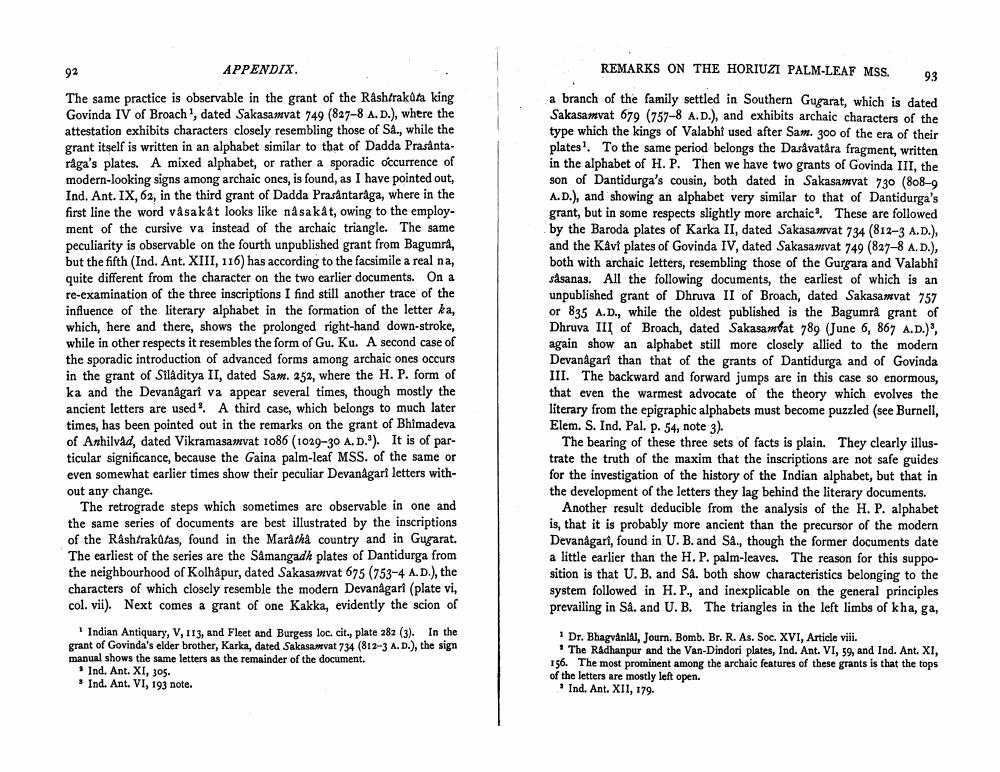________________
92
APPENDIX.
The same practice is observable in the grant of the Râshtrakuta king Govinda IV of Broach', dated Sakasamvat 749 (827-8 A.D.), where the attestation exhibits characters closely resembling those of Sâ., while the grant itself is written in an alphabet similar to that of Dadda Prasantaråga's plates. A mixed alphabet, or rather a sporadic occurrence of modern-looking signs among archaic ones, is found, as I have pointed out, Ind. Ant. IX, 62, in the third grant of Dadda Prasantaråga, where in the first line the word vâsakât looks like nåsakât, owing to the employment of the cursive va instead of the archaic triangle. The same peculiarity is observable on the fourth unpublished grant from Bagumrå, but the fifth (Ind. Ant. XIII, 116) has according to the facsimile a real na, quite different from the character on the two earlier documents. On a re-examination of the three inscriptions I find still another trace of the influence of the literary alphabet in the formation of the letter ka, which, here and there, shows the prolonged right-hand down-stroke, while in other respects it resembles the form of Gu. Ku. A second case of the sporadic introduction of advanced forms among archaic ones occurs in the grant of Silâditya II, dated Sam. 252, where the H. P. form of ka and the Devanagari va appear several times, though mostly the ancient letters are used. A third case, which belongs to much later times, has been pointed out in the remarks on the grant of Bhimadeva of Anhilvåd, dated Vikramasamvat 1086 (1029-30 A. D.3). It is of particular significance, because the Gaina palm-leaf MSS. of the same or even somewhat earlier times show their peculiar Devanagari letters without any change.
The retrograde steps which sometimes are observable in one and the same series of documents are best illustrated by the inscriptions of the Rashtrakutas, found in the Maratha country and in Gugarat. The earliest of the series are the Sâmangadh plates of Dantidurga from the neighbourhood of Kolhapur, dated Sakasamvat 675 (753-4 A.D.), the characters of which closely resemble the modern Devanagari (plate vi, col. vii). Next comes a grant of one Kakka, evidently the scion of
Indian Antiquary, V, 113, and Fleet and Burgess loc. cit., plate 282 (3). In the grant of Govinda's elder brother, Karka, dated Sakasamvat 734 (812-3 A.D.), the sign manual shows the same letters as the remainder of the document.
Ind. Ant. XI, 305. Ind. Ant. VI, 193 note.
REMARKS ON THE HORIUZI PALM-LEAF MSS.
93
a branch of the family settled in Southern Gugarat, which is dated Sakasamvat 679 (757-8 A.D.), and exhibits archaic characters of the type which the kings of Valabhi used after Sam. 300 of the era of their plates'. To the same period belongs the Dasavatâra fragment, written in the alphabet of H. P. Then we have two grants of Govinda III, the son of Dantidurga's cousin, both dated in Sakasamvat 730 (808-9 A.D.), and showing an alphabet very similar to that of Dantidurga's grant, but in some respects slightly more archaic. These are followed by the Baroda plates of Karka II, dated Sakasamvat 734 (812-3 A.D.), and the Kavi plates of Govinda IV, dated Sakasamvat 749 (827-8 A.D.), both with archaic letters, resembling those of the Gurgara and Valabhi såsanas. All the following documents, the earliest of which is an unpublished grant of Dhruva II of Broach, dated Sakasamvat 757 or 835 A.D., while the oldest published is the Bagumrå grant of Dhruva III of Broach, dated Sakasamfat 789 (June 6, 867 A.D.), again show an alphabet still more closely allied to the modern Devanagari than that of the grants of Dantidurga and of Govinda III. The backward and forward jumps are in this case so enormous, that even the warmest advocate of the theory which evolves the literary from the epigraphic alphabets must become puzzled (see Burnell, Elem. S. Ind. Pal. p. 54, note 3).
The bearing of these three sets of facts is plain. They clearly illustrate the truth of the maxim that the inscriptions are not safe guides for the investigation of the history of the Indian alphabet, but that in the development of the letters they lag behind the literary documents. Another result deducible from the analysis of the H. P. alphabet is, that it is probably more ancient than the precursor of the modern Devanagari, found in U. B. and Sâ., though the former documents date a little earlier than the H. P. palm-leaves. The reason for this supposition is that U. B. and Sâ. both show characteristics belonging to the system followed in H. P., and inexplicable on the general principles prevailing in Så. and U. B. The triangles in the left limbs of kha, ga,
Dr. Bhagvanlal, Journ. Bomb. Br. R. As. Soc. XVI, Article viii.
The Radhanpur and the Van-Dindori plates, Ind. Ant. VI, 59, and Ind. Ant. XI, 156. The most prominent among the archaic features of these grants is that the tops of the letters are mostly left open.
Ind. Ant. XII, 179.




